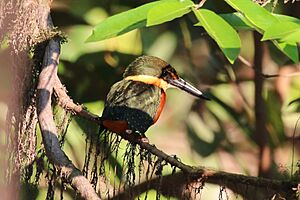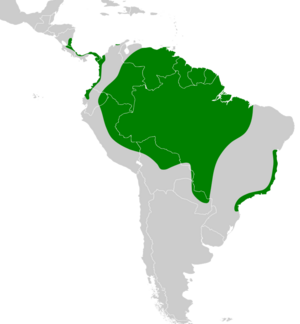Green-and-rufous kingfisher facts for kids
Quick facts for kids Green-and-rufous kingfisher |
|
|---|---|
 |
|
| On the Cristalino River, Southern Amazon, Brazil | |
| Conservation status | |
| Scientific classification | |
| Genus: |
Chloroceryle
|
| Species: |
inda
|
 |
|
| Synonyms | |
|
Alcedo inda Linnaeus, 1766 |
|
The green-and-rufous kingfisher (Chloroceryle inda) is a beautiful bird that belongs to the "water kingfisher" group. You can find it in the warm, tropical parts of the Americas. It lives from Nicaragua down to Panama. It also lives in most South American countries, but not Argentina, Chile, or Uruguay.
Contents
About the Green-and-rufous Kingfisher
How Scientists Name Birds
Scientists use a system called taxonomy to name and group living things. The first official description of the green-and-rufous kingfisher was made by a Swedish scientist named Carl Linnaeus in 1766. He gave it the scientific name Alcedo inda.
Later, in 1848, another scientist named Johann Jakob Kaup put this kingfisher into the group (genus) called Chloroceryle. Studies have shown that the green-and-rufous kingfisher is a close relative of the smaller green kingfisher.
There are two main types, or subspecies, of the green-and-rufous kingfisher. They are called C. i. inda and C. i. chocoensis.
What Does This Kingfisher Look Like?

The green-and-rufous kingfisher is about 24 centimeters (9.4 inches) long. That's about the length of a standard ruler! Males usually weigh between 40 and 60 grams (1.4 to 2.1 ounces). Females are a bit heavier, weighing 53 to 62 grams (1.9 to 2.2 ounces).
This bird has the classic kingfisher shape. It has a slightly messy-looking crest of feathers on its head. It also has a long, strong beak. Its beak is black, with some pale yellow near the bottom part. Its legs and feet can be pinkish or dark gray.
Colors and Patterns
Adult males have shiny green feathers on their upper body. They also have a light yellowish band around their neck. Their wings have white tips on some feathers, and small white spots on others. Their chin is yellowish, their throat is a reddish-brown color, and the rest of their belly is a rich, dark reddish-brown.
Adult females look very similar to males. However, they have a wide green band with white spots across their upper chest. They also have more pale spots on their upper body. Young kingfishers look like adult females but have even more spots on their upper parts. Both young males and females have a green band on their chest, though the male's is thinner.
Where Do Green-and-rufous Kingfishers Live?
The C. i. inda subspecies lives in a much larger area than the other type. It can be found in three separate regions. One region stretches from southeastern Nicaragua, through Costa Rica, and into Panama and Colombia.
Another large area goes from eastern Colombia, across Venezuela, and into eastern Brazil. It also extends south through most of the Amazon rainforest in Brazil, Ecuador, Peru, Bolivia, and Paraguay. The third area is a narrow strip along southeastern Brazil.
The C. i. chocoensis subspecies lives in western Colombia and northwestern Ecuador.
Preferred Homes
These kingfishers love to live near streams and rivers. They also like forested swamps and mangrove areas. They prefer places with lots of plants along the banks, rather than open shorelines. You can find them from sea level up to about 400 meters (1,300 feet) high.
Green-and-rufous Kingfisher Behavior
Movement and Travel
Scientists believe that the green-and-rufous kingfisher usually stays in one place. It doesn't migrate long distances. However, it might move to different areas nearby if there's a flood in the forest.
How They Find Food
The green-and-rufous kingfisher is a skilled hunter. It usually sits on a low branch, often in a shady spot. From there, it dives headfirst into the water to catch its food. Unlike some other kingfishers, it doesn't hover in the air.
Its diet includes small fish, such as those from the Characidae, Cichlidae, and Cyprinodontidae families. It also eats crabs, shrimps, and insects that live in the water.
Reproduction and Life Cycle
The breeding season for the green-and-rufous kingfisher changes depending on where they live. In northern Brazil, they breed from July to November. In Panama, they might also breed in February.
These birds dig a tunnel in an earthen bank, usually along a stream or river. At the end of the tunnel, they make a nest chamber. A female usually lays three to five eggs. Scientists don't yet know how long it takes for the eggs to hatch or for the young birds to be ready to fly.
What Do They Sound Like?
The song of the green-and-rufous kingfisher is described as "thin, high-pitched notes, 'week week week'." They also make a variety of calls. These include a "chip-chip-chip," a "hard, rolling 'drrrt'," a "crackling 'trit-trit-trit'," and a "twitter followed by rapidly repeated, low 'too-too-too-too'."
Conservation Status
The IUCN (International Union for Conservation of Nature) has evaluated the green-and-rufous kingfisher. They have listed it as a species of "Least Concern." This means that it is not currently considered to be in danger of disappearing.
This kingfisher lives across a very large area. Its population is estimated to be at least half a million adult birds. However, scientists believe the number of these birds might be slowly going down. Still, no immediate major threats to their survival have been found.


